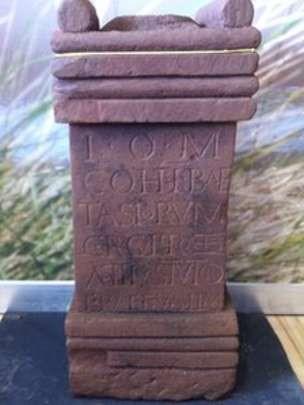The final part of a Cumbrian excavation to unearth the history of what is believed to be the biggest ever find of Roman altars in Britain has begun.
A team of archaeologists and volunteers has spent five years investigating the origins of 17 altars found at Maryport Roman fort in 1870.
Now the final phase of the Maryport Roman Temples project is under way.
Maryport Roman temples excavation enters final phase
BBC News
15 June 2015

The five year project was commissioned by the Senhouse Museum Trust and supported by Newcastle University
The final part of a Cumbrian excavation to unearth the history of what is believed to be the biggest ever find of Roman altars in Britain has begun.
A team of archaeologists and volunteers has spent five years investigating the origins of 17 altars found at Maryport Roman fort in 1870.
Now the final phase of the Maryport Roman Temples project is under way.
Project director, Professor Ian Haynes, said "so much depends" on the "last crucial season" of the dig.
Built on the cliffs overlooking Solway Firth, it is believed the fort was founded in the First Century when the Roman army initially entered the region.
The civilian settlement, which lies north-east of the fort, is believed to be the largest currently known along the Hadrian's Wall frontier.
The altars are housed at the Senhouse Museum Trust in Maryport and form part of a significant collection of Roman sculpture and inscriptions at the museum.
Believed to be the biggest single find of Roman inscriptions ever made in Britain, the altars provide evidence that three regiments from as far away as Spain and Germany were stationed at the fort.

As the altar was found face down in a pit, its dedication to the god "Jupiter Optimus Maximus" was intact

Seventeen altars were found at Maryport Roman fort in 1870

The little Cumbrian town of Maryport was founded by the Romans in 122AD as Alauna Carvetiorum. It was a command and supply base for the coastal defences of Hadrian's Wall at the wall's western extremity

In 2012, the team found another complete altar at the site.
Dated to the 2nd or 3rd Century AD, it was inscribed on behalf of Titus Attius Tutor, commander of the First Cohort of Baetasian, which came to Maryport from what is now the Netherlands.
Prof Haynes said: "We believe that we have located the general area where the altars once stood; in 2015 we will close in on the part of the site where we think that they were originally erected.
"By the end of the season we hope to have a detailed understanding of one of the most important Roman cult complexes ever to have been explored in Britain."
The final excavation ends on 14 August.

Maryport Roman temples excavation enters final phase - BBC News
A team of archaeologists and volunteers has spent five years investigating the origins of 17 altars found at Maryport Roman fort in 1870.
Now the final phase of the Maryport Roman Temples project is under way.
Maryport Roman temples excavation enters final phase
BBC News
15 June 2015

The five year project was commissioned by the Senhouse Museum Trust and supported by Newcastle University
The final part of a Cumbrian excavation to unearth the history of what is believed to be the biggest ever find of Roman altars in Britain has begun.
A team of archaeologists and volunteers has spent five years investigating the origins of 17 altars found at Maryport Roman fort in 1870.
Now the final phase of the Maryport Roman Temples project is under way.
Project director, Professor Ian Haynes, said "so much depends" on the "last crucial season" of the dig.
Built on the cliffs overlooking Solway Firth, it is believed the fort was founded in the First Century when the Roman army initially entered the region.
The civilian settlement, which lies north-east of the fort, is believed to be the largest currently known along the Hadrian's Wall frontier.
The altars are housed at the Senhouse Museum Trust in Maryport and form part of a significant collection of Roman sculpture and inscriptions at the museum.
Believed to be the biggest single find of Roman inscriptions ever made in Britain, the altars provide evidence that three regiments from as far away as Spain and Germany were stationed at the fort.

As the altar was found face down in a pit, its dedication to the god "Jupiter Optimus Maximus" was intact

Seventeen altars were found at Maryport Roman fort in 1870

The little Cumbrian town of Maryport was founded by the Romans in 122AD as Alauna Carvetiorum. It was a command and supply base for the coastal defences of Hadrian's Wall at the wall's western extremity

In 2012, the team found another complete altar at the site.
Dated to the 2nd or 3rd Century AD, it was inscribed on behalf of Titus Attius Tutor, commander of the First Cohort of Baetasian, which came to Maryport from what is now the Netherlands.
Prof Haynes said: "We believe that we have located the general area where the altars once stood; in 2015 we will close in on the part of the site where we think that they were originally erected.
"By the end of the season we hope to have a detailed understanding of one of the most important Roman cult complexes ever to have been explored in Britain."
The final excavation ends on 14 August.

Artist's impression of Maryport Roman temple
Maryport Roman temples excavation enters final phase - BBC News
Last edited: